
2B6.
ENGLISH
DESCRIPTION
This appliance is equipped with a completely automatic system (Advanced Sensor Control) capable to
manage all the functions of your hood. Thanks to the ASC, the air in the kitchen is costantly clean and odour
free without any manual intervention. The advanced sensor catches all sort of vapours, smokes and odours
caused by the cooking process. The ASC also captures an abnormal presence of GAS.
The hood may be installed in the filtering or the ducting version.
Filtering version (Fig.1): The hood aspirates the kitchen air saturated with fumes and odours, purifies it through the
grease filters and charcoal filters and returns clean air into the room. For constant efficiency, the charcoal filters must be
replaced periodically. The charcoal filters are not supplied.
Ducting version (Fig.2): The hood aspirates the kitchen air saturated with fumes and odours, passes it through the
grease filters and expels it to the outside through an outlet pipe. With this version the charcoal filters are not required.
Decide from the outset on the type of installation (filtering or ducting). For greater efficiency, we recommend you install the
hood in the ducting version (if possible).
INSTALLATION
To facilitate installation, before starting remove the grease filter/s: press inward on the clamp at the handle and pull the filter
downward (Fig.3).
Installation on the wall (Fig.4): Using the special drilling template, drill the required holes in the wall. As previously specified
in the chapter “Warning” remember there must be a minimum of 650 mm between the bottom edge of the hood and the stop of
the stove. Secure the metal bracket (B) to the wall using the screws and plugs (bracket, screws and plugs are all supplied with
the unit). Use the 2 triangles cut into the bracket to position it precisely along the vertical axis of the hood. Then set the hood onto
the bracket. Adjust the horizontal position, shifting the hood to the right or left as needed lining it up with the wall units. If the height
of the hood also requires adjustment, use the special regulation screws (V) (supplied). Once regulation has been completed, finish
securing the hood with 4 more screws (M): mark the points for the 4 holes on the wall, remove the hood and drill (8mm diameter
holes); then use the plugs and screws to complete installation.
Installation with rear panel (Fig.5): The rear panel is positioned at the top of the stove, flush against the wall. Rest the lower
edge of the panel behind the stove and anchor the upper edge to the wall using the two holes found on the panel. Insert the screws
and plugs provided (A). The unit is secured to the rear panel as though it were being installed on the wall: use the supplied metal
bracket (B) and the screws and plugs supplied with the panel.
Mount the plate of the electrical system fixing it with 3 screws and 2 metal washers (Fig.6).
Securing the extension pipes:
Basic installation requirements:
– Set the electrical power supply within the space covered by the decorative piping.
– If your unit is installed in an Exhaust hood or in a hood with outside motor, prepare the air exhaust hole.
When installing exhaust hoods and hoods with outside motor, to achieve the best possible conditions use an air exhaust pipe
that: is as short as possible, has a minimum of curves (maximum angle: 90°), is made of a material that complies with the standards
(which vary from nation to nation) and iv) is smooth on the inside. It is also advisable to avoid any drastic changes in pipe section
(diameter: 150 mm).
Adjust the width of the extension pipe support bracket (W) using screws A indicated in Fig.7. Then use the plugs and screws provided
to secure it to the ceiling. Make certain it is aligned with the hood. For filtering hoods, the air exhaust grids are positioned in the
upper part (Fig.8). For exhaust hoods, turn the upper pipe over so that the air exhaust grid is in the lower section (Fig.9).
Exhaust hoods: Connect the hood flange to the exhaust hole in the wall/ceiling using a flexible pipe.
Plug in the hood. Insert the
extension pipes setting them on the hood; extend the upper pipe to the ceiling and secure with the 2 screws (G) (Fig.10).
Filtering hood: Secure the deflector to the upper pipe using the 4 special screws (provided) (Fig.11); hook up the flexible pipe
(diameter: 125) to the deflector. Install the reduction (provided) on the hood air outlet point (Fig.12). Take the 2 assembled extension
pipes and set them on the hood; extend the upper pipe to the ceiling and secure with the 2 screws (G) (Fig.10).
Extend the lower
pipe taping it in place and then connect the flexible pipe to the hood reduction. Plug in the hood. Extend the lower pipe downward
setting it against the hood. Install the carbon filter by pressing the 2 tabs on the filter down into the special housing (Fig.13) and
rotating upward.
OPERATION
Depending on the model, the unit is equipped with the following commands:
CONTROLS shown in Fig. 14:
P1 Switches LIGHTS on and off
P2 min and MAX LIGHT intensity
P3 Nothing happens when pressed with motor OFF. When pressed with motor ON decreases speed until switch-off. Kept
pressed for 2" with motor OPERATING, switches off motor and stores the speed.
P4 When pressed with motor OFF, switches on the motor at stored speed in switch-off or first speed phase When pressed with
motor ON, increases speed.
L1 and shows current speed (GREEN)
P5 Resets filter reset count with motor OFF. NOTE The filter timer is maintained even in the absence of power. With motor ON,
trigger TIMER 5'


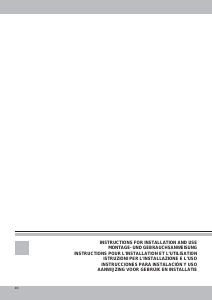

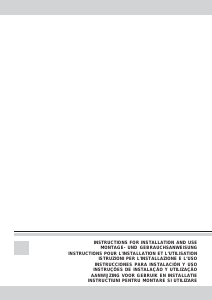
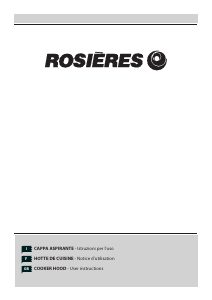
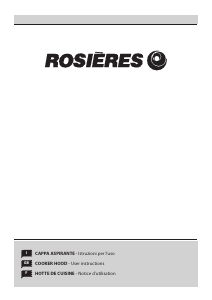
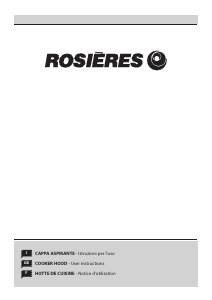
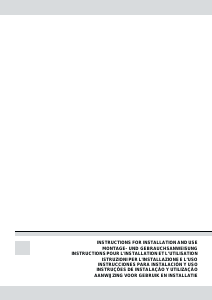
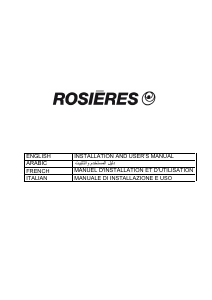
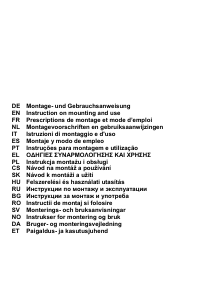
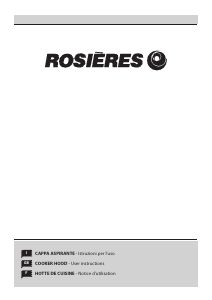
Partecipa alla conversazione su questo prodotto
Qui puoi condividere cosa pensi di Rosières RHD 7 SRB Cappa da cucina. Se hai una domanda, leggi prima attentamente il manuale. La richiesta di un manuale può essere effettuata utilizzando il nostro modulo di contatto.